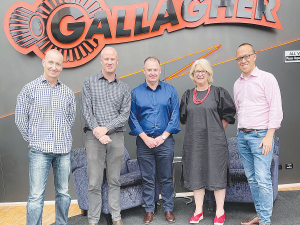Empty rates down
Heat detection technology has helped two Taranaki farmers to cut their herd’s empty rate from 16% to 11% in its first season, says the supplier, Gallagher Group.
 Water deal: from left Scott Goodwin (CFO Gasbot), Chris van der Loo (Gallagher GM global product & technology), Darrell Jones (Gallagher animal management GM NZ & Chile), Sarah Adams (Gallagher global strategy & new ventures manager), Phil Livingston (managing director Gasbot).
Water deal: from left Scott Goodwin (CFO Gasbot), Chris van der Loo (Gallagher GM global product & technology), Darrell Jones (Gallagher animal management GM NZ & Chile), Sarah Adams (Gallagher global strategy & new ventures manager), Phil Livingston (managing director Gasbot).
Gallagher Group has signed an exclusive distribution agreement with Australian company Gasbot to introduce a satellite- based liquid monitoring system to the New Zealand market.
The Gallagher Satellite Water Monitoring system uses Gasbot’s cuttingedge wireless sensor technology to provide timely information on the water levels in tanks, enabling farmers to make informed decisions about water usage and management.
The system uses satellite communications to transmit data from the tanks to the farmer’s mobile phone, providing easy access to tank information even in remote or hard-to-reach locations.
The system is not limited to water tanks but can also be used for diesel and fuel tanks, liquid fertiliser, dams, and troughs. It also minimises the need for manual tank readings, which can be timeconsuming and prone to errors, by automatically alerting farmers when water levels are low.
The system will be available for purchase through Gallagher’s rural retailer network in New Zealand. The first 12 months of the software service is included with the initial purchase, followed by an annual satellite connectivity subscription fee.
Chris van der Loo, Gallagher Global general manager product & technology notes that assurance of water availability is becoming increasingly important for farmers in New Zealand as climate conditions become more unpredictable.
“Being able to monitor the resources available on farm that are needed to care for animals and crops will become more important as we experience the impacts of moving between flood and drought situations very quickly.
“We are very pleased to be working with Gasbot to offer a satellite liquid monitoring solution to provide peace of mind for farmers across New Zealand regardless of how remote they are.”
Gasbot managing director Phil Livingston says his company is committed to helping farmers understand and optimise water use, as well as monitor fuel and liquid fertiliser levels right across their farms, efficiently and cost-effectively.
“These are values which align perfectly with Gallagher’s strategy,” he says.
“We are excited to partner with Gallagher to bring our innovative product to New Zealand. We believe that this product will make a real difference to farmers in the country, providing them with the information they need to manage their liquids and providing alerts when resources are low.”
Both companies are working together to expand the availability the system to other countries.
Fonterra shareholders say they will be keeping an eye on their co-operative's performance after the sale of its consumer businesses.
T&G Global says its 2025 New Zealand apple season has delivered higher returns for growers, reflecting strong global consumer demand and pricing across its Envy and Jazz apple brands.
New Zealand's primary sector is set to reach a record $62 billion in food and fibre exports next year.
A new levying body, currently with the working title of NZWool, has been proposed to secure the future of New Zealand's strong wool sector.
The most talked about, economically transformational pieces of legislation in a generation have finally begun their journey into the statute books.
Effective from 1 January 2026, there will be three new grower directors on the board of the Foundation for Arable Research (FAR).